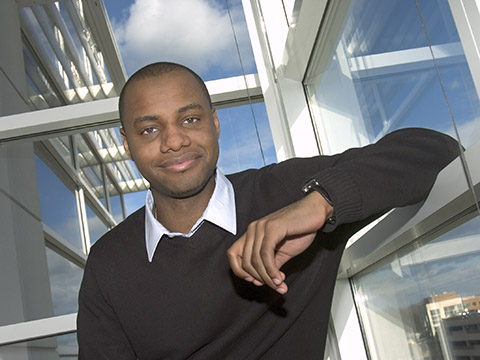
When Jonathan Abraham’s Haitian family moved from Canada to Queens, NY, he was shocked to hear some of his high school classmates blame Haitians for the AIDS epidemic. Even more surprising to him was the number of low-income communities in the United States with rates of infant mortality, TB, and HIV infection comparable to those in developing countries.
Since then, Abraham has focused on two career goals: doing research on infectious diseases and educating people about those diseases.
As an undergraduate at Harvard College, Abraham participated in HHMI’s Exceptional Research Opportunities Program (EXROP), which gives outstanding students from groups underrepresented in science the chance to do laboratory research with HHMI investigators and professors. Abraham worked with HHMI Investigator Stephen C. Harrison, a structural biologist at Harvard. Under Harrison’s guidance, Abraham tried to design drugs to prevent Ebola virus from entering cells.
His project didn’t produce publishable results. But three years later, in 2007, Abraham returned to Harrison’s lab as a graduate student funded by an HHMI Gilliam Fellowship for Advanced Study. Working with Harvard colleagues, Abraham had previously isolated the human cell surface receptor targeted by the deadly South American Machupo virus. Harrison had determined the molecular structure of the molecule called the transferrin receptor.
Within a year of their work on Machupo virus, Abraham, Harrison, and their colleagues determined the molecular structure of the transferrin receptor bound to the Machupo surface protein and published it in Nature Structural and Molecular Biology.
Today, Abraham is a resident in internal medicine at Brigham & Women’s Hospital in Boston and a postdoctoral fellow in the Harrison lab. He hopes to combine a career in infectious diseases with basic science research. And while it’s too early to say whether new treatments for Machupo virus will result from his research, Abraham has succeeded in another way: He has become a skilled, creative scientist.
Image: Tom Kochel
About HHMI's Exceptional Research Opportunities Program and Gilliam Fellowship Program:
It is critical that the nation’s scientists and university faculty reflect America’s diversity. HHMI’s Exceptional Research Opportunities Program (EXROP) places outstanding undergraduate students, nominated by HHMI science education grantees, into intensive research experiences with HHMI investigators and professors. In 10 years since the program’s inception, more than 600 students have participated. Of the EXROP alumni who have completed a baccalaureate degree, nearly half are in graduate school. The Gilliam Fellowship Program provides select EXROP alumni with generous support during their PhD studies.



